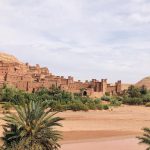Moroccans are extremely hospitable and very tolerant. Though most people are religious, they are generally easy-going, and most young Moroccan women don’t wear a veil, though they may well wear a headscarf. Nonetheless, you should try not to affront people’s religious beliefs, especially those of older, more conservative people, by, for example, wearing skimpy clothes, making out in public, or eating or smoking in the street during Ramadan.
Morocco Culture and Etiquette
Clothes: many Moroccans, especially in rural areas, may be offended by clothes that do not fully cover parts of the body considered “private”, including both legs and shoulders, especially for women. It is true that in cities Moroccan women wear short-sleeved tops and knee-length skirts (and may suffer more harassment as a result), and men may wear sleeveless T-shirts and above-the-knee shorts. However, the Muslim idea of “modest dress” (such as would be acceptable in a mosque, for example) requires women to be covered from wrist to ankle, and men from over the shoulder to below the knee. In rural areas at least, it is a good idea to follow these codes, and definitely a bad idea for women to wear shorts or skirts above the knee, or for members of either sex to wear sleeveless T-shirts or very short shorts. Even ordinary T-shirts may be regarded as underwear, particularly in rural mountain areas. The best guide is to note how Moroccans dress locally.
When invited to a home, you normally take your shoes off before entering the reception rooms – follow your host’s lead. It is customary to take a gift: sweet pastries or tea and sugar are always acceptable, and you might even take meat (by arrangement – a chicken from the countryside for example, still alive of course) to a poorer home.
Tipping: You’re expected to tip – among others but sometimes only when satisfied with the service– waiters in cafés (1dh per person) and restaurants (5dh or so in moderate places, 10–15 percent in upmarket places); museum and monument curators (3–5dh); filling station attendants (3–5dh); and porters who load your baggage onto buses (5dh). Taxi drivers do not expect a tip but always appreciate one.
Mosques: Without a doubt, one of the major disappointments of traveling in Morocco if you are not Muslim is not being allowed into its mosques. The only exceptions are the partially restored Almohad structure of Tin Mal in the High Atlas, the similarly disused Great Mosque at Smara in Southern provinces or Moroccan Sahara, the courtyard of the sanctuary-mosque of Moulay Ismail in Meknes and the Hassan II Mosque in Casablanca. Elsewhere, if you are not a believer, you’ll have to be content with an occasional glimpse through open doors, and even in this you should be sensitive: people don’t seem to mind tourists peering into the Kairaouine Mosque in Fez (the country’s most important religious building), but in the country, you should never approach a shrine too closely.
This rule applies equally to the numerous whitewashed Koubbas – the tombs of marabouts, or local saints (usually domed: Koubba actually means “dome”) – and the “monastic” zaouias of the various Sufi brotherhoods. It is a good idea, too, to avoid walking through graveyards, as these also are regarded as sacred places.
Women in Morocco: There is no doubt that for women especially, traveling in Morocco is a very different experience from traveling in a Western country. One of the reasons for this is that the separate roles of the sexes are much more defined than they are in the West, and sexual mores much stricter. In villages and small towns, and even in the Medinas of large cities, many women still wear the veil and the street is strictly the man’s domain. Most Moroccan men still expect to marry a virgin, and most women would never smoke a cigarette or drink in a bar, the general presumption being that only prostitutes do such things. It should be said, however, that such ideas are gradually disappearing among the urban youth, and you will nowadays find some Moroccan women drinking in the more sophisticated bars, and even more often in cafés, which were, until quite recently, an all-male preserve. In the Villes Nouvelles of large cities, and especially in the Casa–Rabat–El Jadida area, and in Marrakesh, you’ll see most women without a veil or even a headscarf. You’ll also see young people of both sexes hanging out together, though you can be sure that opportunities for premarital sex are kept to a minimum. Even in traditional Moroccan societies, mountain Berber women, who do most of the hard work, play a much more open role in society, and rarely use a veil.












